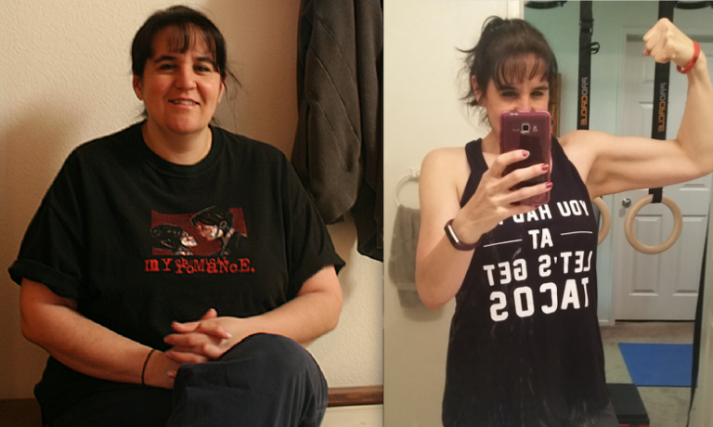Как привести в форму английский для спортзала
Содержание:
- Front Squat vs. Back Squat: Basic Overview
- Примеры схем интервальной тренировки кроссфит
- Особенности Кроссфита
- How to Do the Perfect Pull-Up: Proper Pull-Up Form
- Differences In Strength
- Pull-Ups
- Results
- Кривая обучения
- Оборудование для занятий кроссфитом
- Squat Clean CrossFit Technique Explained
- Front squats and quads
- Термины и аббревиатуры кроссфита
- Conclusion
- 8 Assisted Pull Up Variations/Alternatives
- Benefits of the low-bar back squat
- Level 2 Pull-Up Workout: Inverted Bodyweight Rows
Front Squat vs. Back Squat: Basic Overview
Generally speaking, you should target to front squat about 80-90% of the amount of weight that you back squat. The muscles that you use are a little bit different, and maintaining a good ratio helps you maintain an even build.
As you improve a front squat or back squat, you will also improve the opposite kind of squat. Doing both squats will target different kinds of muscles, but it’s still using your whole body!
Squats are generally not thought to be bad for your knees anymore. Obviously, squats are a more strength-based exercise, and so that might not make them the right exercise for everyone. But for the most part squats are not going to damage your knees or make you unathletic and lumbering.
Squats are a difficult, explosive exercise that puts a great strain on your muscles to build the ability to cut and move with power. While squats can be really great to build you up–you have to make sure that you’re getting a full workout routine. Focus on cardio, quality eating, and good sleep while you’re building your squat routine. And consider adding some nutrients and supplements to your diet! You can even search supplements by your workout goals, and use code “CODY15” for 15% off and free shipping in the US.
Use Intuition
If a certain type of squat doesn’t feel good, don’t do it. If front squats just make more sense for the natural rhythms of your body, that’s okay. If back squats make you feel more stable and comfortable with the weight, that’s okay too. All of the differences, pros, and cons below do not outweigh the similarities between front squats vs. back squats.
There are bonus points in weight lifting for consistency and technique–there are no bonus points for doing something that is awkward and uncomfortable. If one squat feels better to you from the beginning, stick with that one until you build up some strength for the other variation.
Are Squats Bad for My Knees?
For most people, squats are actually really good for the knees. Even if you have aging knees, squats can work through the aches and kinks without doing damage. The key here is to do the squats correctly! You want to keep the motion fluid with the legs about shoulder-width apart.
Don’t overload the weight. If you put too much weight on the bar, different muscles and tendons are going to be strained. You want to make sure that your joints simply guide the movements. They shouldn’t bear any of the load–because they can’t! If squatting hurts things on your body that aren’t muscles, you may want to lower the weight and focus on your form.
Can I Squat Too Low?
Some people will tell you to drop that weight all the way to the floor, while others may warm that going too deep can damage your joints. Neither is usually true. The key is to pay attention to your body–this is so important in every exercise. Pay attention to how your body feels during and after workouts where you hit different kinds of squats. Going lower is generally better, but focus on the movement and not simply on how low you can get. Get low, and then focus on exploding upward. The upward drive is always going to be important.
Getting below parallel when you squat is important because it can activate different parts of the quad muscles than if you simply sit down to 90 degrees.
Do Squats Burn Calories?
Of course! If you’re about 150 pounds, you can burn about 300 calories through 20 minutes of hard squats. This is part of the reason that it is so important to eat quality foods and give your body plenty of proteins to rebuild.
Примеры схем интервальной тренировки кроссфит
Подобного рода программа составляется по принципу отталкивания от возможностей спортсмена, наличия требуемого инвентаря и знания техники.
Примерная однодневная программа упражнений для кроссфита на начинающем этапе может включать три упражнения, например:
- 10 подтягиваний в 1 круге;
- 20 отжиманий в 1 круге;
- 20 выпрыгиваний (берпи) в 1 круге.
Выполняется 3-6 кругов (раундов) с секундным перерывом или без в зависимости от варианта тренировки и подготовки спортсмена.
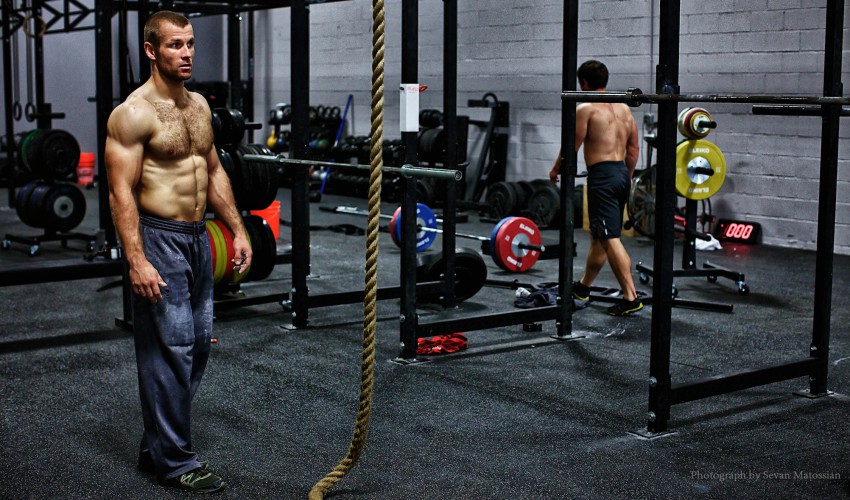
Другой вариант кроссфит тренировки подразумевает выполнение:
- подъема ног из положения вис на турнике – 20 раз в 1 круге;
- отжиманий от пола или скамьи – 30 раз в 1 круге;
- приседаний с собственным весом – 40 раз в 1 круге;
- бега на короткое расстояние (400 — 500 м) или прыжков на скакалке – 20 — 30 сек. в 1 круге.
Выполняется 3-6 кругов (раундов) с секундным перерывом или без в зависимости от варианта тренировки и подготовки спортсмена.
Если во время тренировки одолевает усталость, нельзя допускать полной остановки на выполненном упражнении. Достаточно отдохнуть в течение 10 – 15 секунд и закончить повторение раундов.
Профессионалы советуют не злоупотреблять упражнениями, действие которых направлено на одну группу мышц. Выполнение таких упражнений друг за другом окажет сильной воздействие на мышцы, в результате чего из-за сильного их закисления кроссфитер замедлится в продвижении по программе. Например, отжимания после брусьев нежелательны, так как оба упражнения воздействуют на толкающие группы мышц.
Классификация упражнений в кроссфите
Правильная программа кроссфит тренировки подразумевает чередование упражнений из разных групп. К таковым относятся:
— тянущие (жимы штанги в различных положениях, отжимания);
— толкающие (отжимания, брусья, бурпи);
— кардио (бег, выпрыгивания берпи);
— задействующие ноги.
Например, за 20 минут тренировки можно выполнить 1 круг с 3 разными упражнениями.
- 5 подтягиваний в 1 кругу;
- 10 отжиманий от пола в кругу;
- 15 выпрыгиваний в кругу.
Задачей кроссфитера является выполнение как можно большего количества раундов за 20 –ти минутную тренировку. Главным критерием прогресса при данном виде кроссфит программы служит увеличение раундов за одинаковый временной период.
Например, определенное количество повторений, распределенное на раунды, требуется выполнить как можно быстрее. Главным критерием прогресса служит сокращение временного периода.
Данная программа кроссфита подразумевает самостоятельное определение количества раундов.
Так тренировка по данной программе может выглядеть следующим образом:
- подтягивания на турнике – 100 раз за все круги;
- подъем ног из положения вис на турнике – 200 раз за все круги;
- отжимания от пола или скамьи – 200 раз за все круги;
- прыжки на скакалке (прыжки с поворотом) – 400 раз за все круги.
Отметив начало тренировки на секундомере кроссфитер приступает к выполнению упражнений, повторения определяются в зависимости от физической подготовки и выносливости
Важно помнить о необходимости отмечать количество повторений по каждому упражнению. Учет общего количества повторов за отведенный временной период требует запоминания времени, счета и упражнений, на котором происходит остановка
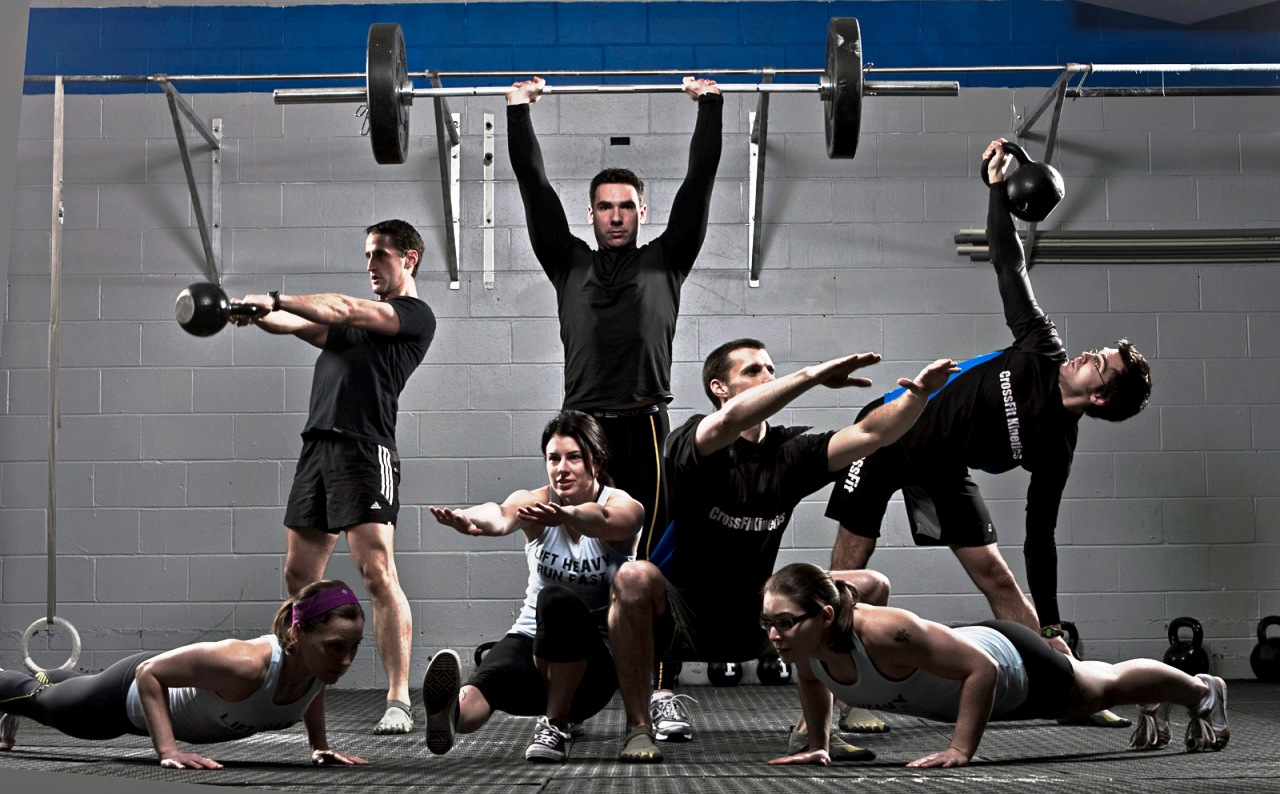
Особенности Кроссфита
Когда ты пытаешься стать частью некоего сообщества, то неплохо бы научиться понимать его участников и знать местные неписанные правила. Вот быстрый обзор некоторых уникальных особенностей кроссфита.
ВОД (WOD). Кроссфит имеет богатую собственную лексику и одно из важнейших и самых простых слов – ВОД (WOD –Workout of the Day – тренировка дня или комплекс дня). Это слово каждое утро пишут на во всех залах по всей стране. И это именно то слово, которое ты увидишь первым, придя в новый зал. И это именно то слово, которое ты будешь чувствовать всем телом по пути домой. Этот комплекс включает в себя «постоянно изменяющиеся, высокоинтенсивные, функциональные движения»
Его цель – сделать атлета лучше, быстрее, сильнее и именно на нем ты сосредоточишь всё своё внимание в этот день. Вот еще ряд терминов из мира кроссфита, с которыми тебе придется жить:. Вот еще ряд терминов из мира кроссфита, с которыми тебе придется жить:
Вот еще ряд терминов из мира кроссфита, с которыми тебе придется жить:
- Девочки — набор базовых комплексов, которые носят имена девушек. Когда основателя КроссФита Грэга Глассмана (Greg Glassman) спросили, почему он назвал их женскими именами, то он ответил: «Каждый комплекс, после которой ты лежишь на спине, таращишься в небо и не понимаешь, что только что произошло, заслуживает женского имени».
- Палео — любимая диета кроссфитеров, которая предполагает питание в стиле наших предков – пещерных людей. А это значит – много мяса и овощей, минимум молочных продуктов, бобовых и зерновых, сахара и крахмала.
- Киппинг – небольшое, но мощное движение всего тела, которое начинается с бедер. Используется, чтобы придать импульс телу, особенно при подтягивании.
- АМРАП (AMRAP) или зкмбр – акроним обозначающий «закончить как можно больше раундов». Данное указание часто встречается в ВОД’ах.
- RX’d – означает, что тренировка была выполнена в точности как написано (с предписанным весом и количеством кругов / повторений).
- Подвижность (Mobility) – тренинг, направленный на развитие моторики и подвижности суставов, позволяющий телу выполнять движения в полной амплитуде.
How to Do the Perfect Pull-Up: Proper Pull-Up Form
We already discussed how to perform a pull-up above but, like everything, there is a right and a wrong way to do them. Here are the most important points of performance to keep in mind.\
1. Start From a Straight Arm Hang
You MUST start from a straight-arm hang! Training in the full range of motion (ROM) is of the utmost importance for injury prevention – including tendonitis – of the elbow and shoulder.
2. Do a Scapular Pull-Up
The initial movement should start with a scapular pull-up (shoulder blades back and down). This protects the shoulder and prevents you from pulling with your upper traps.
3. Use Your Lats – Not Your Traps
Do not pull with your upper traps! We go through life overusing these guys as it is which leads to posture problems, pain and injury. The pull-up is the perfect way to detrain this muscle but it all starts with awareness and then the scap pull-up. Really focus on using the lat muscles (beneath your shoulder blades toward the outside) to initiate the actual pull and try to keep them ‘on’ the entire rep.
Please recheck those traps in your chin-over-bar position as well – if they are in your ears, try focusing on driving your elbows behind you. Or, use assistance until you are able to perform the rep perfectly.
4. Your Chin Must Clear the Bar
Your chin must clear the bar at the top of the pull, and NOT by you straining your neck to get there. Again, training full range of motion (ROM) is of the utmost importance for injury prevention, and in this case, building strength!
No matter which version of the pull-up you are doing, these points of performance must be followed for your own safety, injury prevention and strength gains! Plus, if you ever plan to compete and pull-ups come up in a workout, you need to be able to perform the full ROM so you won’t be ‘no-repped’.
Pull-Up Training (Training to do a Pull-Up)
Now that you know how to do the perfect pull-up, we want to help you get your first one! We put together this 3-week training guide to help you get your first pull up.
Differences In Strength
Chin ups put the biceps in a stronger line of pull, so most people will usually be stronger at chin ups than they are at pull ups.
For example, if you can normally do 10 chin ups, you may only be able to do 6 pull ups. And if you’re using a lat pull-down machine with these grips or doing pull ups/chin ups with added weight, you’ll often find that you can use more weight with chin ups than you can with pull ups.
Similarly, most beginners to either exercise (or just beginners in general) will usually find that they’re able to do a chin up before they can do a pull up.
For me though it’s actually the other way around, which is definitely rare and kinda strange. It’s probably because pull ups were the only vertical pulling exercise I did during my first few years of training. For most people though, chin ups will be your stronger exercise.
Pull-Ups
To start with, I want to talk about wide-grip pullups where the hands are placed outside your shoulder width.
In general, wide-grip pullups are going to have a slightly increased emphasis on recruitment of the lats.
Wide grip pullups put more emphasis on the lats
The reason for this is when the arms are out wide, the biceps are actually placed in a mechanically disadvantaged position, whereby the lats are forced to do a bit more work during the exercise.
This is coupled with the fact that when you’re in a pull-up position, your hands are pronated, a thing which takes away one of the other functions of the bicep – supination.
When you’re gripping the bar with a wide grip, you have an increased capacity to perform adduction at the shoulder joint, and that allows you to increase the recruitment of the lats.
Compare that to a close-grip chin-up or a close-grip pullup where the elbows are forward in front of the body – you can’t get as much of that forceful adduction that demands more recruitment of the back.
Additionally, there’s less overall elbow flexion required to complete a full range-of-motion wide-grip pullup compared to a standard pullup or a standard chin-up.
Results
Interestingly (aka weirdly), EMG data showed no difference between front and back squats in any of the activities of muscles measured. That’s right, no difference in any of the quadriceps, hamstring or back muscles –- at least from a statistics standpoint. If you look at the data closely, there are some differences that in a larger group might be statistically significant. In cases with small differences between measures, statistics usually requires more samples –- in this case lifters -– to determine a difference. (But good luck finding more people with such desirable squat histories!)
Comparing just the averages, we find the back squat had higher hamstring activity (biceps femoris and semitendinous) compared to the front squat. The back squat also had lower quadriceps activity in two of the three muscles measured (vastus lateralis and rectus femoris), while vastus medialis activity was nearly identical in both squats. Last, front squats had higher back muscle (erector spinae) activity compared to back squats.
Analysis of biomechanical data found there were higher compressive and knee extensor moments in the back squat compared to the front squat. However there was no difference in shear stress on the knee, which was actually fairly low -– a lot lower than, say, knee extensions.
| Back squat | Front squat | |
|---|---|---|
| EMG data: muscle activation | ||
| Hamstrings | Higher | Lower |
| Quadriceps | ||
| Vastus lateralis | Lower | Higher |
| Rectus femoris | Lower | Higher |
| Vastus medialis | Similar | Similar |
| Low back (erector spinae) | Lower | Higher |
| Biomechanical analysis | ||
| Compressive force | Higher | Lower |
| Knee extensor moments | Higher | Lower |
| Shear stress | Similar | Similar |
Кривая обучения
В 2009 году на Играх по кроссфиту лучший результат при выполнении рывка составил 240 фунтов (109 килограмм), а в 2012 году, на региональных состязаниях, лидеры выполняли рывок уже с весом в 295 фунтов (139 Кг). Вывод? Даже лучшие атлеты в мире кроссфита продолжают совершенствоваться и учиться чему-то новому. Мастерски овладеть гимнастическими движениями или упражнениями из арсенала тяжелой атлетики не так уж и просто. И многие отличные атлеты совершенствуются, попутно обучая новичков в мире кроссфита в местных залах по всему миру.
Кроссфит поощряет создание сообщества совершенно нового образца, так что не страшись массы, красоты и скорости своих новых соратников. Когда-то они все были новичками.
Оборудование для занятий кроссфитом

В занятиях кроссфитом, пожалуй, один из самых богатых арсеналов оборудования во всем силовом фитнесе:
– различные силовые тренажеры
– штанга
– гири
– гантели
– турник
– брусья
– гимнастические кольца
– TRX – петли
– скакалки разных моделей
– наклонные и вертикальные лестницы
– скамьи со сменным углом наклона
– степ-платформы
– балетный станок
– боксерские мешки и манекены
– покрышки от мощных самосвалов
– кувалды и молотки
– эспандеры
– канаты
– фанерные ящики разной высоты для запрыгивания
– кардиотренажеры (беговая дорожка, эллиптический тренажер, велотренажер, гребной тренажер и другие)
– набивные мячи (для подъема и метания)
– медицинболы (тяжелые резиновые мячи для опоры и метания)
– различные утяжелители (на руки, ноги и тело)
– гимнастические палки, бодибары
– очень разнообразные прибамбасы и примочки для узко специальных целей
– различные устройства для выполнения упражнений с весом собственного тела
И т.д. Это только то, что мне удалось видеть собственными глазами. Учитывая, что кроссфит – система «с открытым исходным кодом», набор оборудования ограничен лишь нашей фантазией.
Squat Clean CrossFit Technique Explained
The squat clean is a great training exercise but it is technically hard to master. Getting your squat clean CrossFit technique correct is important. It is worth working on and getting expert advice on. Some tips to keep in mind to get the squat clean technique in CrossFit just right are;
- At the start of the lift, you should find your elbows are touching your knees.
- When you begin to lift it really is important to take a deep breath and engage your core.
- When you are at the top of the clean recovery includes a partial small squat.
- When you drop you need to go into a full squat with your knees and elbows level.
- Your chest should be kept up all the time
- When moving from the clean to the squat do not take a breath here.
Front squats and quads
Front squats win vs back squats as far as isolating quadriceps is concerned. Are they better for bodybuilding, then? Debatable.
Most bodybuilding routines call for high-rep schemes. However, front squats don’t lend themselves well for that type of training. Due to bar position, both lower and upper back has to work extra-hard to keep the torso vertical.
To quote Poliquin Group article, “Every expert agrees that doing more than 6 reps in the front squat is a complete waste of time, as the scapulae retractors cannot hold the proper position isometrically for that long”.
Even then, many people won’t be able to do even 6 reps of front squats with good form. They will have to work up to that number gradually, letting their upper back adjust to the load.
If you are a fan of high-rep bodybuilding training, you’ll likely have to do front squats for low reps, and finish with machines. If that’s the case, you might as well do back squats, since you’ll be targeting quads with machines later anyway.
Alternatively, just do back squats. Bodybuilding.com article claims Arnold favored them, and look how it worked for him.
Термины и аббревиатуры кроссфита
В прошлых раз я написал статью, которая должна помочь новичкам адаптироваться к кроссфит тренировкам. Продолжая данный цикл статей сегодня разберем термины и аббревиатуры (в том числе на английском), которые встречаются в кроссфите и могут быть непонятны для новичков.
Nike Metcon 4
Одни из самых устойчивых кроссовок с прочной подошвой, многослойной пяткой и текстурированной сеткой.
Самая прочная и легкая модель в линейке Metcon
Честно говоря, мне по началу приходилось очень сильно напрягать мозги, чтобы разгадать сокращения терминов, которые применяются в кроссфит. Да и сейчас иногда приходиться обращаться к поисковикам, чтобы посмотреть, как выглядит движение, которое указано кроссфит комплексе в виде аббревиатуры.
Conclusion
There are two ways of looking at the EMG data:
- There is no difference in muscle activation between front and back squats.
- Or, front squatting less weight results in the same activation as back squatting more weight.
While front squats showed no difference, or marginally less muscle activation, you have to remember that lifters also used less weight. So it really isn’t a surprise that compressive forces on the knee during front squats are lower.
The authors suggest that if you have knee problems, such as ligament damage or meniscus tears, or if you have problems with osteoarthritis, then you may want to stick with the front squat since compressive forces can damage knee cartilage.
Another thing: if you look just at squats in general, both front and back, forces on the anterior cruciate ligament (ACL) (as measured by posterior shear forces) are low. Shear forces are so low, in fact, that many experimenters suggest that squats are safe for patients with ACL damage.2 So much for squats being bad for your knees! Oh, and machine squats were found to have 30-40% higher shear forces than free weight squats.3
Now isn’t it time you went and worked on that squat? Maybe the experimenters will be looking for more participants and you’ll want to be ready…
8 Assisted Pull Up Variations/Alternatives
- Chin up: Chin ups are like pull ups, but with one difference: your palms face towards you, rather than away from you. Chin ups are challenging, but noticeably easier than pull ups, which makes them great for building your strength on pull ups if you can only do a few pull up reps.
- Flexed arm hang: Hold yourself up for as long as you can in the top position of a pull up or chin up (chin over the bar, arms bent and elbows in line with your hips from a side view). If you’re too weak to pull yourself up, stand on a chair or stool to help get into position.
- Neutral grip pull up: This is just like chin ups/pull ups, except you use parallel handles that allow you to use a neutral grip (palms facing each other). Like chin ups, hammer grip chin ups are a little easier than pull ups. As such, it’s a good exercise to do when you can do just a few pull ups.
- Kipping pull up: This pull up variation entails generating momentum by swinging your hips, legs, and arms to bring you through the motion. This variation is best if you are already capable of doing a couple reps of regular pull ups.
-
Band-assisted pull up: Secure a resistance band
to the pull up bar so one end of the loop is hanging down. Put one foot or knee into the loop to create tension and effectively reduce your body weight. Perform as many pull ups as desired. The band helps the most at the bottom of the rep, which is often the most difficult point in the motion. Use stronger bands to start off with, and work your way to weaker bands as you progress. - “Jump-up” with negative: Jump into the positive positive rep of a pull up. The idea is to create enough momentum to get to the top of the motion. Once there, concentrate on performing the negative rep by slowly lowering yourself down. Repeat. If the jumping part is too difficult for you, or if the bar is too high, then get a chair or bench to stand on to reach the bar so you can perform just the negatives. This pull up variation is nice because you get to train the basic pull up motion on the positive rep (with a reduced load from the momentum), while getting used to your full body weight on the negative rep.
-
Assisted pull up machine: Set the weight stack to the desired level. The heavier the weight setting, the easier the movement. Grasp the bar and step (or kneel) onto the sliding platform, and perform your set of pull ups. This pull up variation is inferior to band-assisted because it doesn’t require as much stabilization work. Plus, your body is more vertical than it would be on band-assisted or conventional pull ups. That said, this variation still has merit, as it can strengthen the major muscles involved in pull ups, and get you accustomed to the basic vertical pulling motion.
-
Lat pulldown: Set the stack to the desired resistance. Sit down and set the knee pad over your lower thighs to keep you anchored. Grasp the bar and pull the bar down to your chest, then go back to the top. Repeat. Lat pulldowns only mimic a fraction of the necessary movement for pull ups, since you remain seated and don’t utilize the stabilizing muscles. And so, lat pulldowns will help improve your pull up strength, but progress will be slower if not done in conjunction with one of the above variations. Note: Although lat pulldowns aren’t the best pull up variation, they’re great for adding mass to your lats.
Benefits of the low-bar back squat
The low-bar back squat is a great option for anyone who struggles to keep proper form in a heavy high-bar back squat, Boorstein said.
“The high-bar back squat puts a lot of tension on the knees if you have long legs. If, after years of trying to correct the problem, your knees come in and your back rounds during a high-bar back squat, you might want to try a low-bar squat,” he said.
The low-bar back squat puts the bar in a position over the midline, which makes the core, lower back, glutes, and hamstrings do the work, versus the quad-dominant high bar variation. The movement is ideal for athletes with tight ankles who struggle to get into the bottom of a high-bar back squat while staying upright.
The lower bar placement and torso-forward position of the low-bar back squat make it almost impossible to get into that cringe-inducing, hunched-over, rounded back position you often see when someone is struggling to stand up a heavy high-bar back squat. And better positioning means less chance for injury—especially when the barbell is loaded.
Related: The Secrets to the Perfect Squat
Level 2 Pull-Up Workout: Inverted Bodyweight Rows
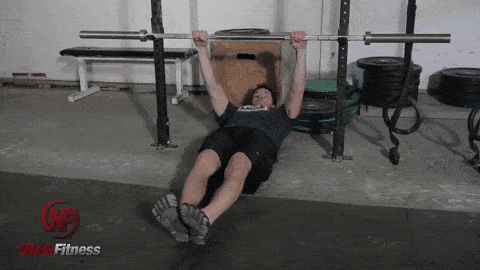
Bodyweight rows are the PERFECT precursor to pull-ups – they work the same muscles, and have you lifting your own bodyweight, just at a different angle.
For this level, we’ll provide you with two options: You can also make adjustments.
OPTION A: IF YOU HAVE ACCESS TO A GYM OR WANT TO JOIN A GYM
You can follow the rest of this workout as part of our 6-Level Gym workout guide, which will help you go from total gym newbie to pull-up progressing badass!
At your gym, find your Smith Machine and set the bar at about chest height.
A higher bar makes the exercise easier to start:

And as you get stronger, you can set the bar lower:
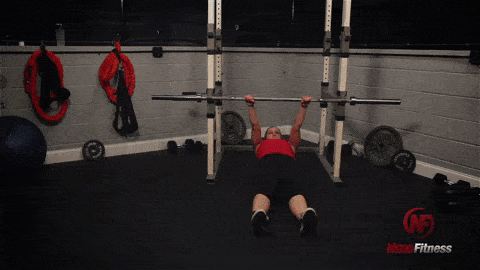
Here’s a whole post I did on inverted bodyweight rows.
Here’s how to do an inverted bodyweight row (here is a video demonstration with gymnastic rings, but you can start with a bar as displayed in the images below).
- Set the bar at a height where it’s challenging for you to complete 3 sets of 8 reps with two minutes of rest between sets.
- Clench your butt and keep your abs tight and body straight throughout the exercise.
- Pull your shoulder blades down and back towards each other (like you’re trying to pinch a pencil between them behind your back).
- Focus your mind on PULLING with your arms.
- Pull until your chest touches the bar (not your neck).
- As soon as you can complete all 3 sets of 8 reps, set the bar heigh lower to make the exercise more difficult.
If you need to make the exercise less challenging, bend your knees and put your feet flat on the ground:
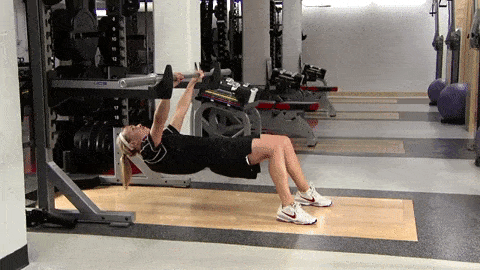
Level 2 sample workout routine:
Monday – 3 sets of 8 reps of overhand bodyweight rows
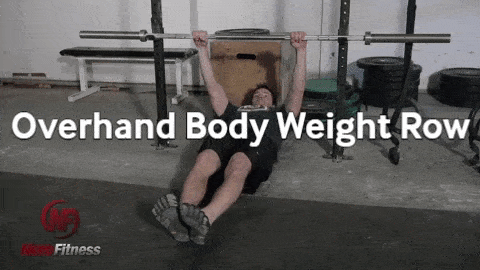
Wednesday – 3 sets of 8 reps of underhand bodyweight rows (hands reversed)
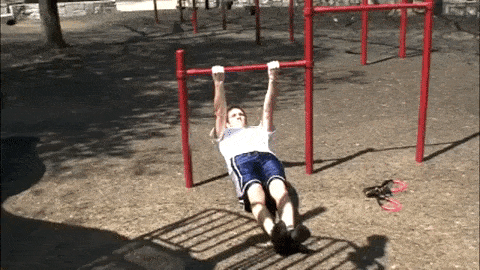
Friday – 3 sets of 8 reps of overhand bodyweight rows
(And then go underhand, overhand, underhand the following week)
As soon as you’re doing bodyweight rows where your body is at a 45-degree angle or lower, you can .
OPTION B: IF YOU DON’T HAVE ACCESS TO A GYM FOR INVERTED ROWS
You have 4 paths here:
1) Purchase a door frame pull-up bar, hang a pair of gymnastic rings from them. And then follow the same advice as above!
2) Use your kitchen table for rows (BE CAREFUL):
3) Do inverted rows between a couple chairs, as we walk you through in How to Do Pull-ups Without a Bar:

4) Move up to Level 3 and progress with caution there.
If you are struggling with rows, you’re not sure you’re doing them correctly, or you’re not sure how to progress to the next level, check out our 1-on-1 coaching program.
It’s the type of program that helped single mom Leslie lose 100+ pounds and start training with gymnastic rings and handstands!
